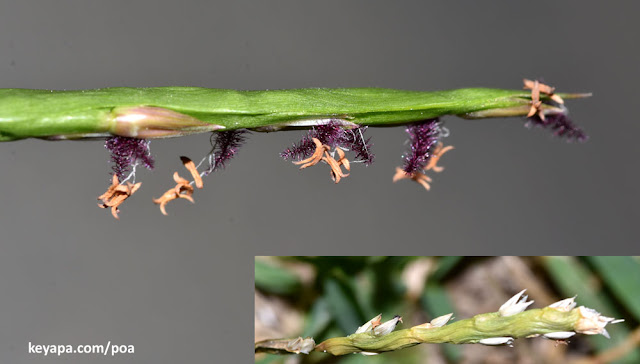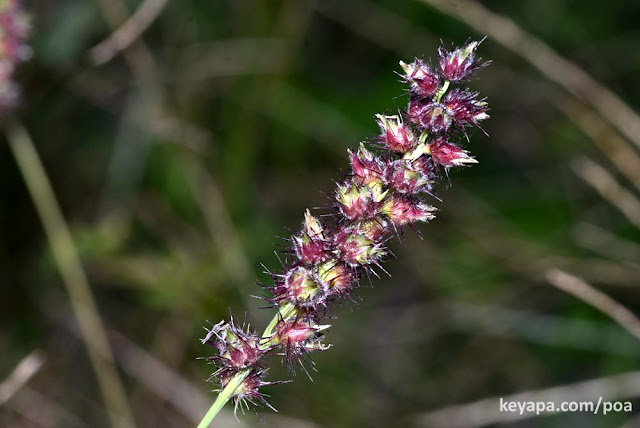 |
| Bambusa vulgaris 'Vittata' (Striped Timber Bamboo) |
Bamboos form the subfamily Bambusoideae, and there is no doubt that they are some of the most beautiful grasses around. Their colorful culms, delicate leaves, and the majestic heights reached by some bamboo species, make them a favorite of many plant collectors and growers, and their economic importance as structural materials is second to none in the Poaceae. In addition, bamboos hold a special place in the cultures of many East Asian countries.
 |
| Bambusa malingensis (?) dwarfs passersby |
I visited the
Harry P. Leu Botanical Garden in Orlando, FL and spent some time marveling over these plants, but also discovered a few other new grasses that I had never encountered before.
As always, the bamboos were probably one of the highlights for many of the people visiting the garden. People were especially enthralled by the larger specimens, which towered over them and rose to reach the heights of the surrounding trees. Unfortunately, even though there were signs that urged people not to do so, I saw instances of culms with the initials of visitors carved into them.
 |
| Bambusa vulgaris |
There is a common misconception that the bamboos are the most "primitive" of the grasses (probably due to the fact some are woody), but recent studies show that the Bambusoideae diverged after the rice subfamily (Oryzoideae), and much later than the three earliest grass subfamilies (Anomochlooideae, Pharoideae, and Puelioideae). More on grass phylogeny in some future post, I promise.
Although many of the specimens I found were varieties of Bambusa vulgaris (Timber Bamboo), there were quite a few other species that caught my eye.
A medium sized bamboo (Dendrocalamus minor 'Amoenus') that had a bluish tint to its culms entranced me.
 |
| Dendrocalamus minor 'Amoenus' |
I was also interested in a smallish bamboo with the funny name of Pseudosasa japonica 'Tsutsumiana' that was hidden among its towering brethren. Its form and attractive foliage made me think it would make a nice houseplant, if only it stopped growing at a manageable height! But the highlight of my trip turned out to be some of the non-Bamboo grasses.
 |
| Pseudosasa japonica 'Tsutsumiana' |
A few of the species that were also in the bamboo section of the park looked remarkably like small bamboo, but were in fact not in the subfamily Bambusoideae at all!
 |
| Thysanolaena latifolia |
Thysanolaena latifolia (called Tiger Grass in some places, and Broom Grass in others) had elegant broad leaves, and I thought at first it was another bamboo. The specimen I found in the shade sported dried flowerheads that looked like brooms, and in their native habitat they are in fact used for sweeping.
 |
Thysanolaena latifolia seedheads
|
Another grass that really caught my attention was a small cutie that only reached to my calf called Pogonatherum paniceum. It looked like a bamboo as well, and it had gorgeous striped leaves and an attractive roundish habit. It is used as an ornamental in some places, and I have a feeling I might get one for my garden someday.
 |
| Pogonatherum paniceum |
One other specimen that held my attention showed up near the end of my visit. The day was coming to a close, and I was hurrying towards the exit when I came upon an entire section that was dedicated to ornamental, and other, grasses.
In addition to the usual ornamental grass suspects like Miscanthus spp, as well as economically important species like Saccharum officinarum (Sugarcane), the lot had a species that I had been hearing about a lot in my sojourns on facebook, but which I had never seen in person.
 |
| Chrysopogon zizanioides (Vetiver grass) habit |
Chrysopogon zizanioides, which is also called Vetiver grass, is a species which has its own groups in Facebook, and its many economic benefits has been been touted loudly and repeatedly by its many boosters around the world.
 |
| Chrysopogon zizanioides (Vetiver grass) seedheads |
C. zizanioides is considered part of a low cost technology solution that has helped to solve various problems. It has a massive root system that grows vertically and deep into the soil, which makes it ideal for erosion control. These same roots also spread and slow down runoff so it passes harmlessly across farmland, and the ability of the grass to tolerate very high levels of heavy metals makes it ideal for soil remediation. It is also used for pest control in that it is attractive to many insect pests (e.g. stem borer moths), which lay their eggs on the plants instead of nearby crops. The larvae who feast on C. zizanioides die due to chemicals in the grass that interfere with their digestive system.
It really is a so-called 'Miracle' Grass to the many people around the world who have used it!
Here are some of the species that I discovered and mapped by GPS in the Harry P. Leu Botanical Gardens:
Bamboo:
Bambusa dissimulator
Bambusa eutuldoides 'Viridivittata'
Bambusa malingensis
Bambusa multiplex
Bambusa multiplex 'Golden Goddess'
Bambusa oldhamii
Bambusa textilis var gracilis
Bambusa vulgaris
Bambusa vulgaris 'Vittata'
Dendrocalamus asper
Dendrocalamus minor 'Amoenus'
Otatea fimbriata
Pseudosasa japonica 'Tsutsumiana'
In addition to the bamboos, I was happy to find some Other Grasses:
Arundo formosana
Chrysopogon zizanioides
Miscanthus spp
Pogonatherum paniceum
Thysanolaena latifolia
Saccharum officinarum
Trypsacum spp
...and a few more that I had no time to survey due to the park closing.
For visitors to the park later, I created a google map of the specimens that I found. You can find it here:


















